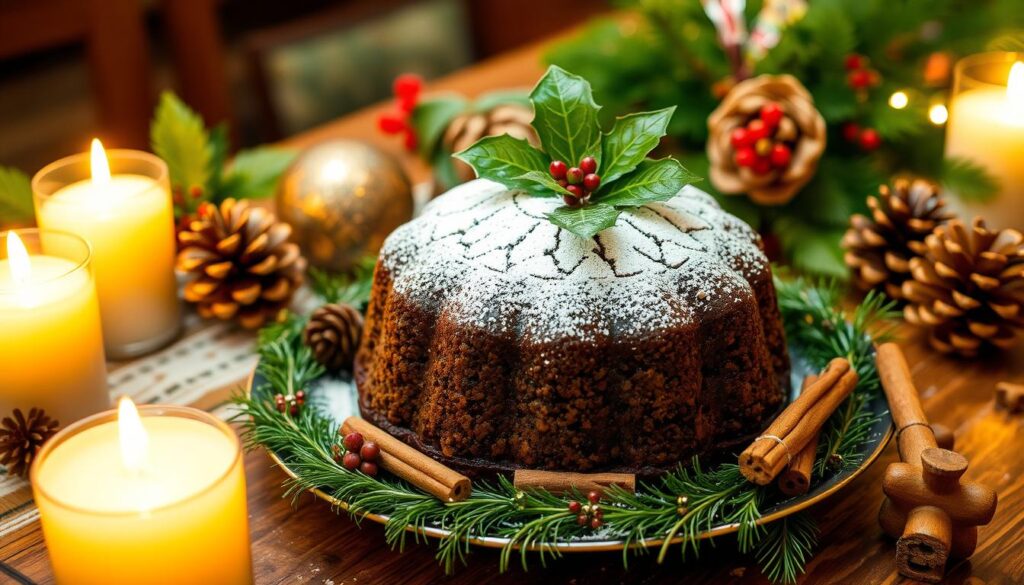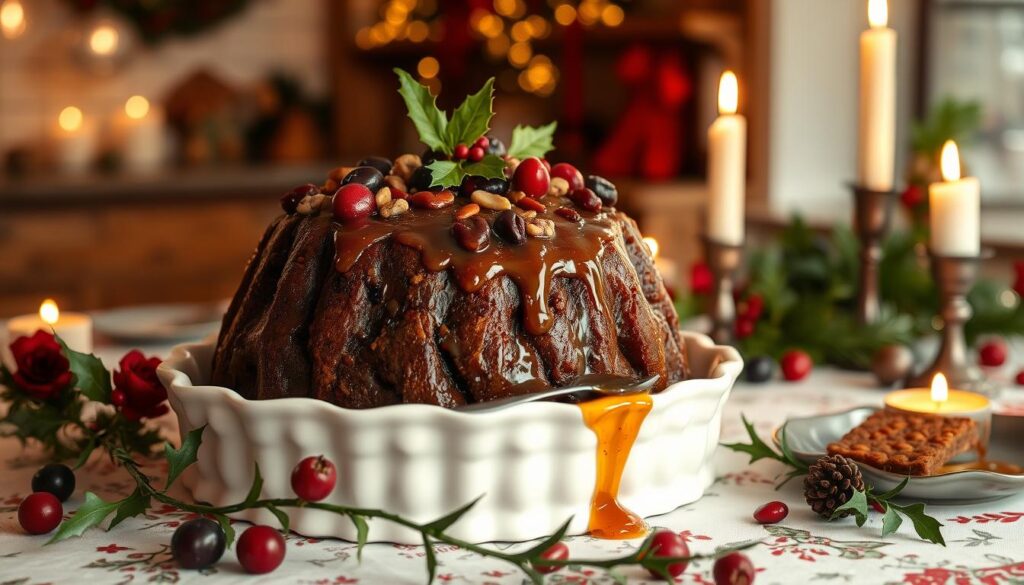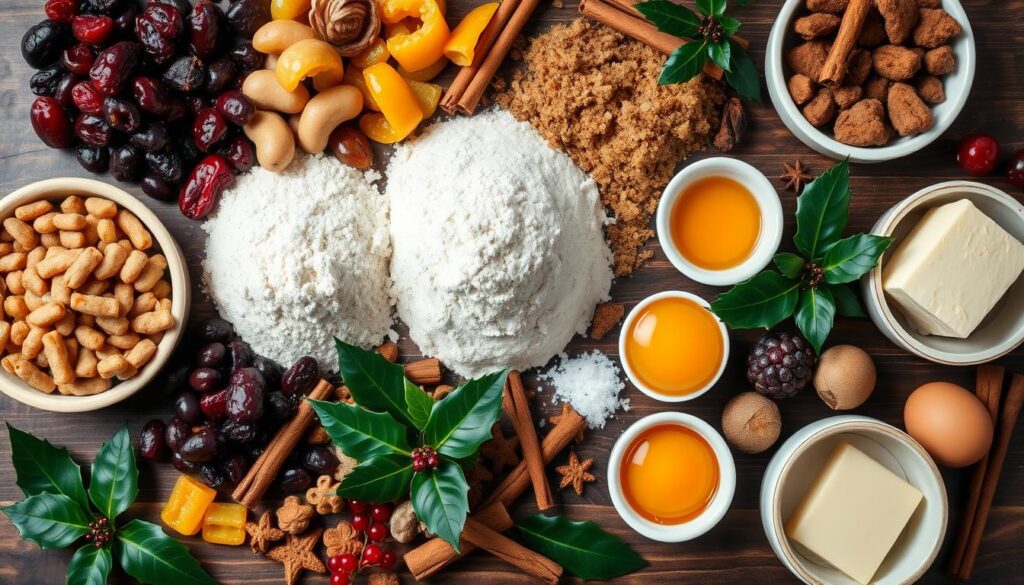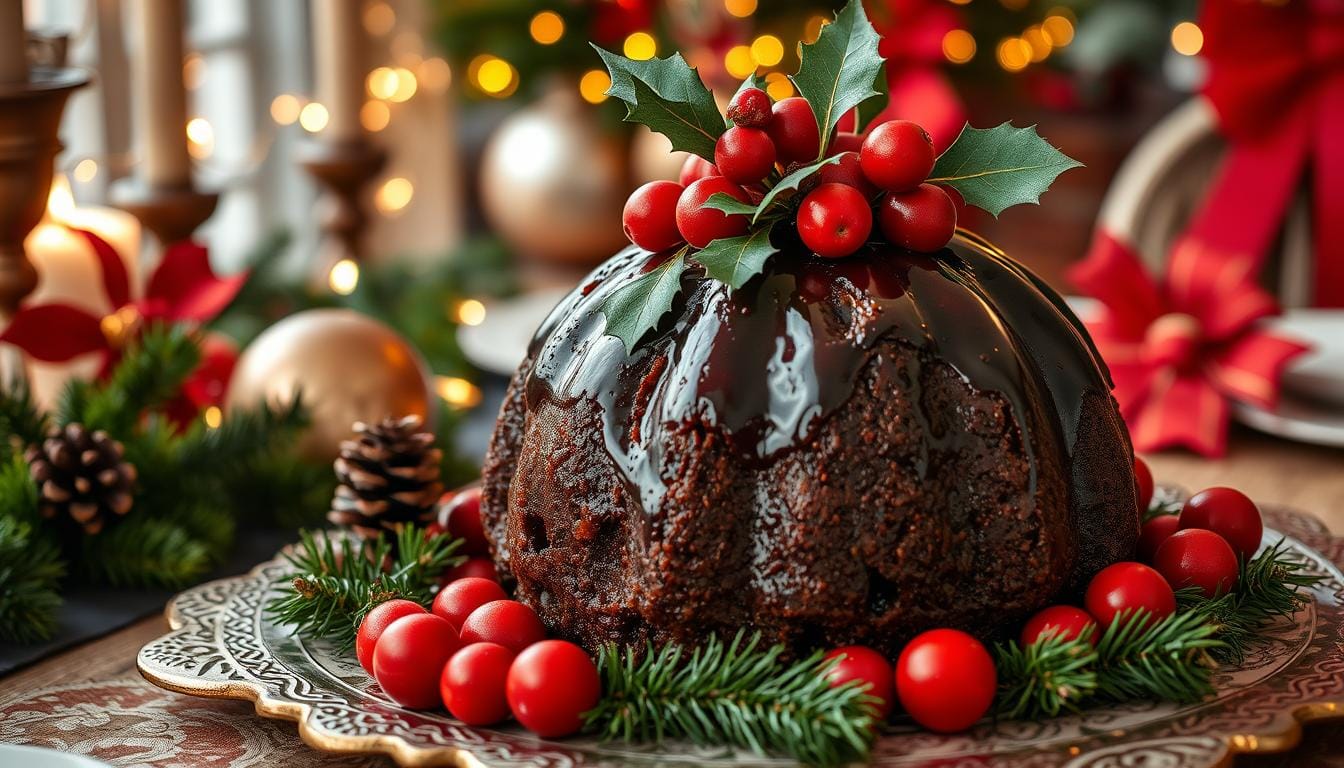Christmas pudding is a favorite holiday treat in British and Commonwealth cuisine. It has been around for centuries, starting in medieval England. The first recipes were from the 17th century. It’s a key part of the Christmas feast, showing the season’s culinary traditions.
The dish’s history comes from savory puddings and croustades. Over time, it became the sweet, dried-fruit dessert we love today. By the 18th century, the sweet parts of plum pudding were more popular. This change gave Christmas pudding its unique taste.
Now, Christmas pudding is enjoyed worldwide, not just in the UK. Countries like Australia, New Zealand, Canada, and South Africa love it too. This shows the dish’s lasting popularity and the British colonial influence. From its simple start to today, Christmas pudding is a holiday classic.
What is Christmas Pudding?
Christmas pudding is a key part of Traditional British Cuisine. It has its roots in medieval England, starting as a savory dish. Now, it’s a sweet Dried Fruit Cakes loved by many.
The modern Christmas pudding is filled with dried fruits, candied peels, and spices. This mix creates a complex flavor that embodies the holiday spirit.
Origins of Christmas Pudding
The history of Christmas pudding goes back to the 14th century. It was first mentioned in British cooking records. Back then, it was a savory dish with meat, vegetables, and spices.
Over time, it became sweeter with dried fruits and sugar. Now, it’s a cherished Christmas dessert.
Definition and Ingredients
Christmas pudding is a dense, rich sponge cake. It’s made with dried fruits like raisins and currants. Candied citrus peels add a special touch.
The pudding also has suet, breadcrumbs, flour, eggs, and spices. Cinnamon, nutmeg, and cloves are common. Some recipes include brandy or rum for extra flavor.

“Christmas pudding has become a beloved tradition, a delicious way to celebrate the holiday season and bring families together.”
The History of Christmas Pudding
The Christmas pudding has a long history, starting in the Middle Ages. Back then, it was a savory dish called “frumenty.” It was made with meat and dried fruits, making it hearty and tasty.
But with the rise of sugar in the 16th century, the recipe changed. It became the sweet, dense dessert we love today.
Medieval Roots of the Dish
The Christmas pudding’s roots go back to medieval English sausages. These were made with fat, spices, and fruits in the early 15th century. By the end of the 16th century, dried fruit made plum pudding sweet.
Changing Ingredients Over Time
Over the years, Christmas pudding’s ingredients have changed a lot. In the mid-1600s, plum pudding became a Christmas favorite. But in 1647, Oliver Cromwell banned it.
In the 19th century, the recipe became more standard. It included suet, brown sugar, raisins, and spices. This made it a beloved holiday tradition.
The pudding’s high alcohol content helped it last over a year. This made it great for sending to British frontiers and soldiers in places like Afghanistan. During the Victorian era, families would gather to make the pudding on “Stir-up Sunday.”
As the British Empire grew, the pudding got ingredients from around the world. It included dried fruits, cinnamon, and spices. This showed the influence of British imperialism and the pudding’s adaptability.

In the last century, making Christmas pudding has gotten easier. Modern recipes use molds and focus on safety. Yet, the pudding remains a cherished part of Holiday Baking and Family Recipes in Europe.
Traditional Ingredients You’ll Need
To make the perfect Brandy-Infused Sweets for your Christmas Dinner, you need the right ingredients. Dried fruits add sweetness, while spices bring warmth and depth. Each part is key to the classic taste of a traditional Christmas pudding.
Fruits and Nuts
Dried fruits are the heart of Christmas pudding. Raisins, currants, and sultanas are common choices. Candied peel from oranges and lemons adds a citrusy twist. Chopped almonds or other nuts add crunch.
Spices and Sweeteners
The spices make Christmas pudding special. Cinnamon, nutmeg, and mixed spice are must-haves. Suet or a vegetarian substitute adds fat. Brown sugar and molasses make it sweet and rich.
Alcohol in the Recipe
Brandy or rum is a traditional addition. It adds a warm, boozy flavor. It also helps keep the pudding fresh for months.
| Ingredient | Purpose |
|---|---|
| Dried Fruits (Raisins, Currants, Sultanas) | Provide natural sweetness and texture |
| Candied Peel (Orange, Lemon) | Add a citrus flavor note |
| Cinnamon, Nutmeg, Mixed Spice | Contribute to the traditional spice blend |
| Suet or Vegetarian Alternative | Provide the necessary fat content |
| Brown Sugar, Molasses | Lend a deep, rich sweetness |
| Brandy or Rum | Infuse the pudding with a boozy flavor and help with preservation |

With these ingredients, you can make a Brandy-Infused Sweets centerpiece for your Christmas Dinner. The secret is finding the right mix of fruity and spicy flavors. This will make your holiday treat unforgettable.
Preparing the Pudding Batter
Making the perfect Christmas pudding begins with carefully preparing the batter. Start by soaking dried fruits like raisins, currants, and prunes in brandy or rum overnight. This step adds a rich, festive flavor to the fruits.
Then, mix your dry ingredients in a large bowl. Use flour, breadcrumbs, suet, spices, and baking powder. Whisk until they’re well mixed. In another bowl, beat eggs and mix in the soaked fruits, any leftover liquid, and sweeteners like brown sugar or honey.
Step-by-Step Mixing Instructions
- Slowly add the wet ingredients to the dry, mixing well for even consistency.
- The batter should be thick but still moist. Add milk or brandy if it’s too dry.
- It’s a tradition for each family member to stir the mixture, making a wish.
Tips for Achieving the Right Consistency
- The batter should be thick, like heavy cake batter.
- Don’t over-mix to avoid a dense, tough pudding.
- If it’s too thick, add more liquid. If too thin, add breadcrumbs or flour.
Now, pour the batter into a greased pudding basin. Cover it with parchment and foil, then tie it with kitchen string. This will help your Holiday Treats and Family Recipes come together for a wonderful Christmas feast.
The Importance of ‘Stir-Up Sunday’
As the holiday season gets closer, many families look forward to making the Christmas pudding. For ages, the last Sunday before Advent is called ‘Stir-Up Sunday’. It’s a day for families to mix and prepare the ingredients for this special Christmas dessert.
Significance of Stir-Up Sunday
The name ‘Stir-Up Sunday’ comes from the 1549 Book of Common Prayer. It starts with the words “Stir up, we beseech thee, O Lord.” This prayer, read on the last Sunday before Advent, is linked to stirring the Christmas pudding mix.
Back then, Stir-Up Sunday was when families made the pudding together. They would stir it, with each family member taking a turn. This was believed to bring good luck and symbolize family unity.
Family Traditions Associated with It
- In some homes, silver coins or charms are added to the pudding mix. Finding a coin is thought to bring luck.
- The pudding is stirred from East to West, honoring the three wise men who visited Jesus.
- While stirring, families make wishes, strengthening their bonds and creating a festive mood.
Even though making homemade Christmas puddings is less common, Stir-Up Sunday remains important. It reminds families of the value of coming together and keeping culinary traditions alive.
Cooking Methods for Christmas Pudding
Preparing the perfect Christmas pudding involves steaming. This method can take up to 8 hours. The pudding basin is placed in a large pot with water halfway up its sides. This allows the steam to cook the pudding gently.
Steaming Your Pudding
To steam your Christmas pudding, start by greasing the pudding basin. Then, line it with a double layer of parchment paper or muslin cloth. Pour in the prepared batter and cover the top with a sheet of pleated foil or a pudding cloth.
Secure it tightly with string, creating a handle for easy removal. Place the basin in a large pot filled with simmering water. Ensure the water level comes halfway up the sides of the basin. Cover and steam for the recommended cooking time, topping up the water as needed.
Oven-Baking Techniques
Some recipes allow for oven-baking the Christmas pudding. This method produces a slightly denser texture. It’s a convenient alternative to the lengthy steaming process.
To oven-bake, preheat your oven to 325°F (165°C). Bake the pudding in its basin for 4-5 hours, or until a skewer inserted comes out clean.
After the initial cooking, whether by steaming or baking, Christmas puddings are often stored for weeks or months. This allows them to mature and develop their rich, complex flavors. Before serving, the pudding is reheated, either by steaming or gently warming in the oven. It may be flambéed with brandy for a dramatic presentation.
“The smell of a freshly steamed Christmas pudding is one of the most comforting and nostalgic aromas of the holiday season.”
| Cooking Method | Cooking Time | Texture | Convenience |
|---|---|---|---|
| Steaming | Up to 8 hours | Dense and moist | Requires more time and attention |
| Oven-Baking | 4-5 hours | Slightly denser | More convenient, but still requires significant time |
Whether you choose to steam or bake your Christmas pudding, the end result will be a delightful, holiday-inspired dessert. It will fill your home with the warm, spiced aromas of the season. With a bit of patience and the right techniques, you can create a truly memorable Steamed Puddings and Holiday Baking experience.
How to Store Your Christmas Pudding
After making your homemade Christmas pudding, it’s important to store it right. This keeps its flavor and texture just right. Whether you’re eating it now or saving it for later, the right storage makes a big difference.
Short-Term Storage Methods
For a few days, you can keep your Christmas pudding at room temperature. Wrap it tightly in parchment paper and foil. Then, store it in a cool, dry spot. This keeps it fresh for up to a week.
For longer storage, the fridge is a good choice. Wrapped well, it stays good for a week. It keeps its taste and texture just right.
Long-Term Preservation Tips
The alcohol in Christmas pudding helps it last longer. Cool it down, then wrap it in fresh paper and foil. Store it in a cool, dark spot. This way, it can last up to a year.
Some people add more brandy or rum to their Christmas pudding over time. This makes the pudding even more flavorful.
Freezing Christmas pudding isn’t needed for long storage. The alcohol and sugar keep it fresh. But, if you freeze it, it stays good for two years.
Remember to label your Christmas pudding container with the date. This helps you keep track of how fresh it is. With the right storage, you can enjoy your holiday treats for months.
Serving Suggestions for Christmas Pudding
Christmas pudding is a favorite festive dessert. It’s traditionally served warm, especially after a Christmas dinner. You can enjoy it with brandy butter, rum sauce, or creamy custard. But, there are also modern ways to make it even more special.
Traditional Accompaniments
The most common ways to enjoy Christmas pudding are:
- Brandy butter – A luxurious spread made with butter, brandy, and powdered sugar
- Rum sauce – A decadent sauce with a boozy kick, often poured over the warm pudding
- Custard – A creamy, vanilla-flavored custard that complements the pudding’s dense texture
- Heavy cream or ice cream – A scoop of whipped cream or a dollop of ice cream adds a cooling contrast
Modern Twists to Enjoy with It
For a modern twist, try these:
- Mascarpone or crème fraîche – These rich, creamy accompaniments lend a touch of elegance
- Chocolate sauce – A drizzle of decadent chocolate sauce adds a luxurious twist
- Deconstructed versions – Layered in a trifle or incorporated into an ice cream
- Cake pops or muffins – Mini desserts made with leftover Christmas pudding
No matter how you serve it, Christmas pudding will be the highlight of your Festive Desserts and Christmas Dinner.
Tips for Flambéing Christmas Pudding
Flambéing your Christmas pudding is a tradition that brings drama and a hint of brandy flavor. It dates back to Victorian times, symbolizing the burning love of God. But, it’s key to follow safe practices for a successful flambé.
Why Flambé?
Flambéing your Christmas Pudding makes it look stunning and adds a brandy flavor. This tradition is loved during Christmas, making the feast more exciting.
Safe Techniques for Flambéing
- Use a long-handled lighter to ignite the Brandy-Infused Sweets, ensuring a safe distance from the flame.
- Keep a fire extinguisher nearby in case of any unexpected flare-ups.
- Never carry a lit pudding, as this can be dangerous. Instead, carefully pour the warmed brandy or rum over the pudding and ignite it on the serving table.
- Some prefer using vodka for a cleaner flame that doesn’t alter the pudding’s flavor.
By following these simple safety precautions, you can create a spectacular and memorable flambé presentation. It will delight your guests and make your traditional Christmas Pudding even better.
Variations of the Classic Recipe
The traditional Christmas pudding recipe is a beloved Family Recipe. But, there are many new twists and variations for different tastes and diets. From gluten-free to vegan, there’s a version for everyone to enjoy.
Gluten-Free Christmas Pudding
For those with gluten sensitivities, gluten-free Christmas pudding recipes use rice flour or special gluten-free blends. These keep the pudding’s rich, moist texture while meeting dietary needs.
Vegan Christmas Pudding
Vegan versions of Christmas pudding use plant-based fats like vegetable shortening or coconut oil instead of suet. Raisins, dried fruits, and nuts add the classic flavors. Spices like cinnamon, nutmeg, and allspice give it the Christmas smell.
Some recipes add chocolate or tropical fruits for a new twist. Alcohol-free versions use fruit juice instead of brandy or rum. Regional touches, like maple syrup in New England or whisky in Scotland, show the pudding’s versatility.
“Christmas pudding is a timeless tradition that brings families together, and these modern variations ensure everyone can indulge in the holiday cheer.”
Common Mistakes to Avoid
Starting your holiday baking can be exciting, but beware of common mistakes. These can ruin your Christmas pudding. Knowing these pitfalls helps make your pudding moist, tasty, and a hit with your guests.
Overmixing the Batter
Don’t overmix the pudding batter. This can make your pudding tough and dense. Just mix until the ingredients are combined, not until it’s smooth.
Underestimating Cooking Time
Another mistake is thinking your pudding cooks fast. These cakes need hours to steam and bake. Rushing can ruin the flavors. So, take your time to cook it right.
| Common Mistakes | Solutions |
|---|---|
| Overmixing the batter | Mix just until ingredients are combined, avoid over-mixing |
| Underestimating cooking time | Allow several hours for proper steaming and baking |
| Using old baking powder | Replace baking powder if it’s past its expiration date |
| Not sealing the pudding basin properly | Ensure a tight seal to prevent a soggy pudding |
| Forgetting to check water levels during steaming | Regularly monitor and replenish water to avoid burning |
| Using low-quality ingredients | Invest in high-quality dried fruits, spices, and alcohol |
| Skipping the maturation period | Allow the pudding to mature for optimal flavor development |
By avoiding these common mistakes, you’ll make a perfect Christmas pudding. It will impress everyone at your holiday gathering.
Conclusion: Making Christmas Pudding Your Own
Christmas pudding is special because you can make it your own. Family recipes often have special ingredients or local touches. You can add your favorite dried fruits, try new spice blends, or use plant-based options for different diets.
Personalizing Your Recipe
When making Christmas pudding, let your creativity flow. Maybe your family has a secret ingredient or you want to try something new. Baking this dessert is a chance to create something special for your loved ones.
Keeping Traditions Alive
Christmas pudding is loved worldwide, with recipes changing to fit local tastes. Making this dessert keeps your heritage alive and creates new memories. Every Christmas pudding you make adds to your family’s story.
FAQ
What is Christmas pudding?
Christmas pudding is a sweet, dried-fruit pudding. It’s a key part of Christmas dinner in Britain and other countries. It has medieval English roots and is known for its dark color and long cooking time.
What are the traditional ingredients in Christmas pudding?
It includes dried fruits like raisins, currants, and sultanas. Candied peel, suet, breadcrumbs, flour, eggs, and spices like cinnamon and nutmeg are also used. Alcohol like brandy or rum is added too.
How did Christmas pudding evolve over time?
It started as a savory dish with meat and dried fruit. With more sugar in the 16th century, it became sweeter. By the 19th century, it was a Christmas staple.
What is the significance of “Stir-Up Sunday” for Christmas pudding?
Stir-Up Sunday is the last Sunday before Advent. Families mix the pudding together, making wishes. This tradition began in Victorian times.
How is Christmas pudding typically cooked?
It’s traditionally steamed for up to 8 hours. Modern methods include pressure cooking or slow cookers. Oven baking is less common.
How should Christmas pudding be stored?
Let it cool, then wrap it in fresh parchment and foil. Store it in a cool, dry place for up to a year. The alcohol preserves it.
How is Christmas pudding typically served?
It’s served warm, often at the end of Christmas dinner. It’s often with brandy butter, rum sauce, or custard. Modern options include mascarpone, crème fraîche, or chocolate sauce.
What is the tradition of flambéing Christmas pudding?
Flambéing adds drama and flavor. Warm brandy or rum is poured over and ignited. It symbolizes the Christian theme of God’s love.
What are some variations of the classic Christmas pudding recipe?
There are gluten-free, vegan, and chocolate or tropical fruit versions. Regional twists include maple syrup in New England and whisky in Scotland.
What are some common mistakes to avoid when making Christmas pudding?
Avoid overmixing, underestimating cooking time, and using old baking powder. Make sure the pudding basin is sealed well and check water levels during steaming.

